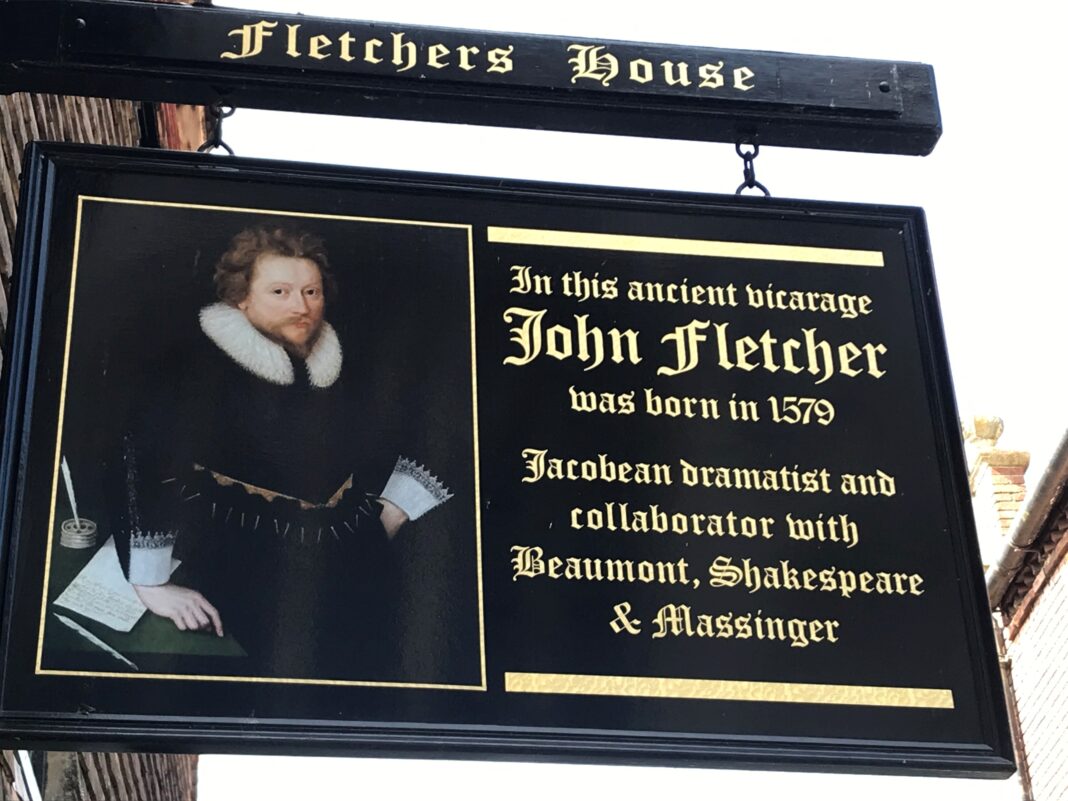There is no disputing that Fletchers House is now a hugely popular and very successful Rye restaurant, transformed from its previous life as a tea room. On the front of this 14th century building is a swinging sign proclaiming that “In this famous vicarage John Fletcher was born in 1579, Jacobean dramatist and collaborator with Beaumont, Shakespeare & Massinger”. The following explanation of this proclamation makes interesting reading.
Fletcher’s father was Richard Fletcher, who was to become successively Dean of Peterborough and then Bishop of Bristol, Worcester and London as well as chaplain to Queen Elizabeth I. He was also in attendance on the scaffold when Mary, Queen of Scots was beheaded at Fotheringhay Castle in 1587. However, in 1579, before his meteoric rise through the ranks of the clergy, he was vicar of Rye. The vicarage was in Church Square, at the time another 14th century building, replaced by the present house during the 18th century. That is where John Fletcher and some of his siblings were born.
Richard Fletcher died in 1596, deeply in debt. He had fallen out of favour with the queen because of his second marriage to a widow, which Her Majesty had advised against. Shortly before his death there had been a reconciliation of sorts with Her Majesty. Upon his death, responsibility for his eight children passed to his brother, Giles. At the age of 11 in 1591, John went up to Corpus Christi College, Cambridge. He was originally intended for holy orders, like his father. There is no evidence that he took a degree. Indeed, little is known of his childhood or time at university. What is known is that he gave up any thought of a pastoral career and, like many young men since, headed to London, for a life in the theatre.
By 1606, Fletcher’s name was starting to be noted as one of the playwrights who wrote for the Children of the Queen’s Revels, who were based at the theatre in Blackfriars. They were members of the choirs of the Chapels Royal, who had been performing, originally in the great hall of the old monastery of the Black Friars, since 1576. When Fletcher was working with them the theatre was in what had been known as the Parliament Chamber of the monastery, to which the troupe had moved in 1600. They stayed there until the next reign, when the King’s Men took over the theatre.
Contemporary reports tell us that at this stage in his career, Fletcher had become friendly with, and was a member of the company of, the renowned Ben Jonson, who wrote for a theatrical company called the Admiral’s Men. However, Fletcher’s most productive association was with Francis Beaumont. They collaborated for about 10 years, possibly from as early as 1605, but it seems likely that their long collaboration produced only 10 plays. According to John Aubrey the antiquary, they lived in the same house on Bankside, sharing clothes and “having one wench between them.” There is no evidence for this arrangement, other than Aubrey’s. Beaumont married Ursula Isley in 1613, so the cosy bachelor household, if indeed it was that, was ended. The year 1613 also saw the beginning of end of Beaumont himself. He suffered a stroke sometime between February and October that year. He wrote nothing after that, except an elegy for Lady Penelope Clifton. She died on 26th October. Beaumont died on 6th March 1616 and was buried in Westminster Abbey.
Fletcher meanwhile was collaborating with the Bard of Avon, William Shakespeare. They co-wrote Henry VIII and The Two Noble Kinsmen. Another joint work, Cardenio, no longer survives. By himself Fletcher wrote the sequel to Shakespeare’s Taming of the Shrew, known as The Woman’s Prize or The Tamer Tamed. It was written after the death of Shakespeare. Fletcher now seems to have been regarded as Shakespeare’s successor, writing, as he had done, exclusively for the King’s Men. The arrangement lasted until his own death in 1625. He found other collaborators, first Nathan Field and finally Philip Massinger, who himself became the in-house writer for the King’s Men in 1625.
Fletcher was always a popular writer. Three of his plays were given at the court of King James I during the winter months of 1621. Fletcher died, supposedly of plague, in August 1625, aged 45. He was buried in what was then the church of St. Saviour’s, which its congregation had bought from King James for £800 in 1611. Since 1905 it has been called Southwark Cathedral. Its proximity to the 16th and 17th century theatres on the south bank of the Thames has meant that it is the last resting place of many from the theatrical world. It was here that Fletcher was interred, although where exactly is unknown. One source tells us that both Fletcher and Philip Massinger were buried in the same grave. If so, Fletcher must have been there first, as Massinger didn’t die until 1640. There are two stones in the choir marked Edmond Shakespeare 1607 (younger brother of William,) and John Fletcher 1625. They may have been moved from elsewhere.
Always popular and influential in his lifetime (apart from one failure early in his career, the Faithful Shepherdess,) Fletcher’s reputation has declined over the years. He now seems to be regarded as the transition between popular Elizabethan drama and the dramas of the restoration period from 1660.
Image Credits: Nick Forman .



